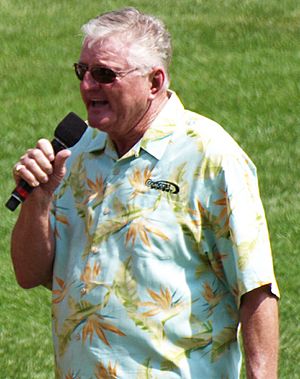Ken Harrelson facts for kids
Quick facts for kids Ken Harrelson |
|||
|---|---|---|---|

Harrelson at U.S. Cellular Field in 2010
|
|||
| First baseman / Right fielder | |||
| Born: September 4, 1941 Woodruff, South Carolina, U.S. |
|||
|
|||
| debut | |||
| June 9, 1963, for the Kansas City Athletics | |||
| Last appearance | |||
| June 20, 1971, for the Cleveland Indians | |||
| MLB statistics | |||
| Batting average | .239 | ||
| Home runs | 131 | ||
| Runs batted in | 421 | ||
| Teams | |||
|
|||
| Career highlights and awards | |||
|
|||
Kenneth Smith Harrelson (born September 4, 1941), known as "the Hawk", is a former professional baseball player and a well-known television announcer. He played in Major League Baseball (MLB) from 1963 to 1971. After his playing days, he spent 33 years as a broadcast announcer for the Chicago White Sox. In December 2019, Harrelson received the Ford C. Frick Award. This award is given each year to a broadcaster for their important contributions to baseball.
Contents
Early Life and Sports
Harrelson was born in Woodruff, South Carolina. His family moved to Savannah, Georgia, when he was in fifth grade. As a child, Ken loved basketball and hoped to play for the University of Kentucky.
He was a talented athlete at Benedictine Military School in Savannah. He played golf, baseball, football, and basketball.
Playing Baseball in the MLB
Ken Harrelson batted and threw with his right hand. He played for four different teams during his nine-season career. These teams included the Kansas City Athletics, Washington Senators, Boston Red Sox, and Cleveland Indians.
In his career, Harrelson had a .239 batting average. He hit 131 home runs and had 421 RBI in 900 games.
Joining the Boston Red Sox
In 1967, Harrelson's time with the Athletics ended suddenly. He was traded to the Boston Red Sox. The Red Sox were trying to win their first championship since 1946. Harrelson helped the team win the American League pennant. However, they lost the World Series to the St. Louis Cardinals.
Harrelson's Best Season
The year 1968 was Harrelson's best season. He was chosen for the American League All-Star team. He hit a career-high 35 home runs. He also led all of Major League Baseball with 109 runs batted in. He finished third in the voting for the American League Most Valuable Player award.
Retirement and Return
Harrelson first announced his retirement in April 1969. He felt his business interests made it hard to move to another city. After talking with baseball officials, he decided to return to play for the Cleveland Indians. He hit a triple in his first game with the Indians. That year, he hit 30 home runs.
In 1970, Harrelson broke his leg during spring training. This injury kept him out for most of the season. In 1971, he retired from baseball to become a professional golfer.
The First Batting Glove?
Ken Harrelson is often given credit for being the first Major League player to wear a batting glove. He used a golf glove in the 1960s to protect his hand. He had gotten blisters from playing too much golf.
However, baseball historians say that batting gloves were used much earlier. Some players used them in the early 1900s. Still, Harrelson helped make batting gloves very popular. By the late 1970s, almost all players wore them.
Life as a Broadcaster
After his playing career, Harrelson started broadcasting baseball games in 1975. He first worked for the Boston Red Sox. He became very popular with fans.
Working for the Chicago White Sox
In 1982, Harrelson moved to become an announcer for the Chicago White Sox. He worked as a White Sox announcer until 1985.
Executive Role
For a short time, Harrelson took on an executive role with the White Sox. He was the executive vice president of baseball operations from 1985 to 1986. During this time, he made some big changes to the team. He later resigned from this role.
Back to Broadcasting
Harrelson returned to broadcasting in 1987 for the New York Yankees. He also worked for NBC on their Game of the Week broadcasts.
In 1990, Harrelson came back to the White Sox as their main television announcer. He worked with different partners over the years. During this time, he won five Emmy Awards. He also won two Illinois Sportscaster of the Year awards.
In 2016, Harrelson started working a reduced schedule. He announced his final year in the broadcast booth would be the 2018 season. He officially retired from broadcasting on September 24, 2018.
On December 11, 2019, Harrelson was honored with the Ford C. Frick Award. This award is given by the National Baseball Hall of Fame and Museum for excellence in broadcasting.
Personal Life
Ken Harrelson married Elizabeth Ann "Betty" Pacifici when he was in high school. They had four children and three grandchildren. They later divorced.
Harrelson was also a very good golfer. After he retired from baseball, he played in the 1972 British Open. He also made the cut at a PGA Tour event in 1980.
On September 13, 1973, Harrelson married Aris Harritos. They have two children and two grandchildren. His son, Casey, played in the White Sox minor league system. The family lives in Orlando, Florida.
See also
- List of Major League Baseball annual runs batted in leaders



